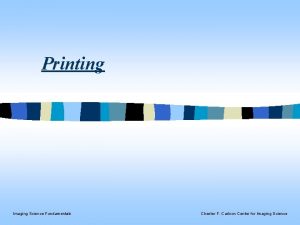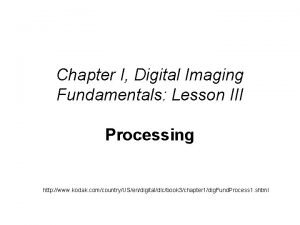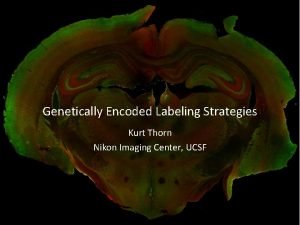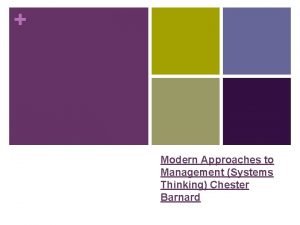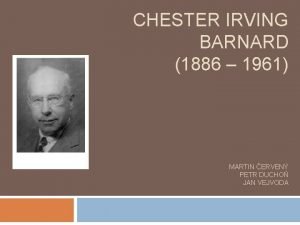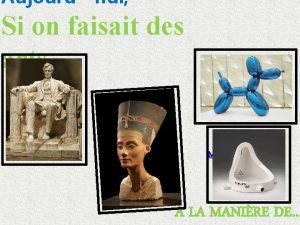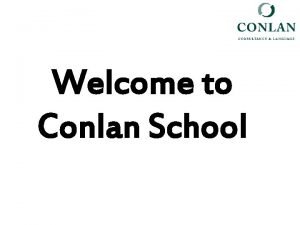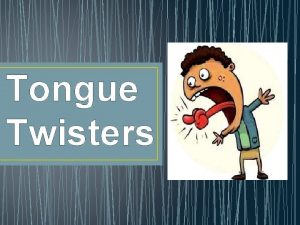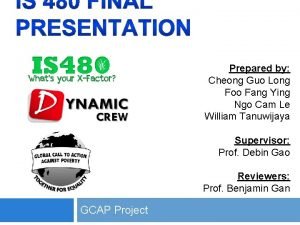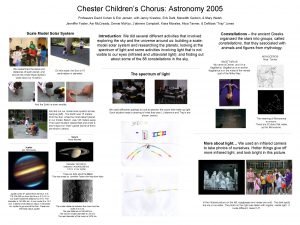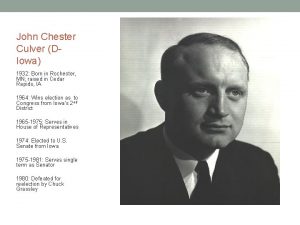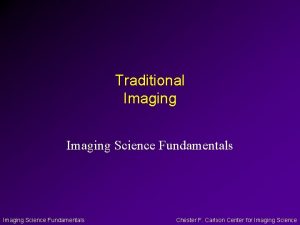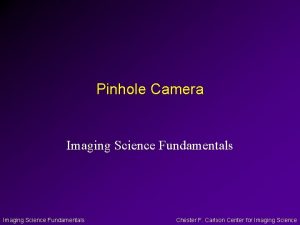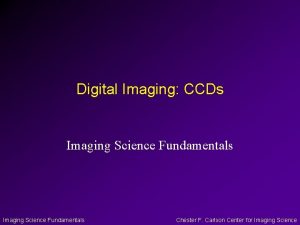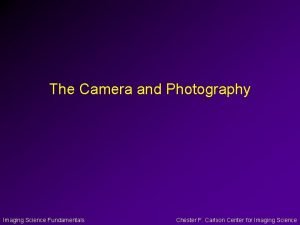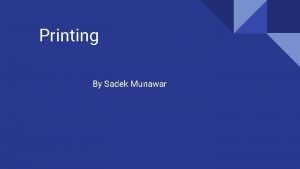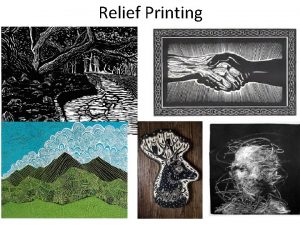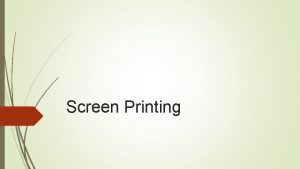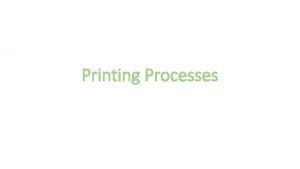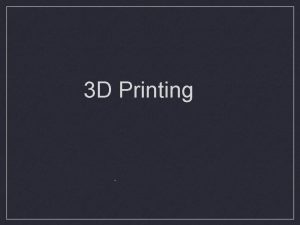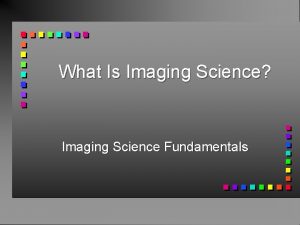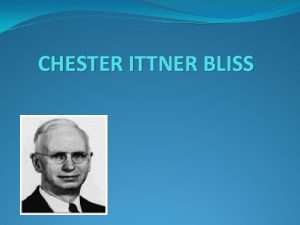Printing Imaging Science Fundamentals Chester F Carlson Center





















- Slides: 21

Printing Imaging Science Fundamentals Chester F. Carlson Center for Imaging Science

Origin of Printing n Invented by Chinese c. 1000 AD – Entire page printed at once • wood cuts • metal type n Reinvented in Europe, Johannes Gutenburg – Entire page printed at once • movable type, could ‘reset’ the plate Imaging Science Fundamentals Chester F. Carlson Center for Imaging Science

Traditional Printing Processes n n Intaglio Letter press / Relief Silk screen / Porous / Stencil process Lithography / Planographic Imaging Science Fundamentals Chester F. Carlson Center for Imaging Science

Lithography/Planographic Process n Plate repels ink Lithography n – Image areas accept ink – Non-image areas repel ink n Absorbs ink for copying Imaging Science Fundamentals Image and non-image areas are on the same plane. Difference: Receptivity of ink The plate image is the same as the print. Chester F. Carlson Center for Imaging Science

Intaglio Printing n n plate n The image is etched or depressed into the plate as small wells, which contain ink. Non-image areas are the surface of the plate. The plate image is the reverse of the final print Imaging Science Fundamentals Chester F. Carlson Center for Imaging Science

Letter/Relief Press n n plate n The image area is raised and inked. The non-image area is depressed. The plate image is the reverse of the final print Imaging Science Fundamentals Chester F. Carlson Center for Imaging Science

Silk Screen/Porous/Stencil Process n T-Shirt Ink Scre en n n Screen Ink goes through n Image areas are porous allowing ink to pass through. Non-image areas are non porous. Metal, nylon, silk screen, or fibrous material is used. The plate image is the same as the print. Ink does not go through Imaging Science Fundamentals Chester F. Carlson Center for Imaging Science

Binary Printing n The traditional printing processes described maintain only two tones: color ink image no color no ink no image All printing methods from this point on, unless otherwise noted, are binary. Imaging Science Fundamentals Chester F. Carlson Center for Imaging Science

Binary Printing n How do printers produces gray tones between the traditional ink and no-ink areas without many gray inks? n Challenge: Find a way to print continuous tone images: Imaging Science Fundamentals Chester F. Carlson Center for Imaging Science

The Halftone Idea n Make a grayscale … with discrete levels of gray. Imaging Science Fundamentals Chester F. Carlson Center for Imaging Science

The Halftone Idea n Early artists used the Halftone Idea and alternatives to make gray with dots or lines: – Stippling, lithography, mezzotint, etc. A work by Albrecht Dürer employs both lines and dots. Imaging Science Fundamentals Chester F. Carlson Center for Imaging Science

The Halftone Idea n Levels of Gray – Decrease the amount of black concentrated in an area to make it look lighter: • spaced lines and dots – Increase the area covered in black to darken it: • condensed lines and dots Imaging Science Fundamentals Chester F. Carlson Center for Imaging Science

The Halftone Idea n The spacing and size of markings used to simulate gray depend on: – Human Visual System: • Don’t want people to distinguish lines / spots • Roughly, people see up to 60 lines per inch (lpi) at 2 ft. – Viewing Distance Zoom farther out and the dots appear smaller. Imaging Science Fundamentals Chester F. Carlson Center for Imaging Science

The Halftone Idea n Two Types of Halftone Spots: – AM: Amplitude (or Area) Modulated spots have a fixed screen ruling and vary in size – FM: Frequency Modulated spots have a fixed size and vary in line spacing. Imaging Science Fundamentals Chester F. Carlson Center for Imaging Science

Impact Printers n Impact Printing – A needle/head physically hits an ink ribbon onto paper leaving an impression behind. n n Dot Matrix Printers – Set of 9 or 24 pins form spots – Text and low quality imagery; FM halftones – 1 or 4 color ribbons Typewriter, 1874 – QWERTY keyboard becomes standard – Text only; No halftones – 1 color ribbon Imaging Science Fundamentals Chester F. Carlson Center for Imaging Science

The Halftone Idea n Structures of Digital Halftone Cells Conventional/ AM/Clustered Imaging Science Fundamentals Stochastic/ FM/Dispersed Chester F. Carlson Center for Imaging Science

Spatial Resolution n dpi = dots per inch n lpi = lines per inch – Each dot that makes up a halftone spot – Associated with optical resolution of scanners and addressability of digital printers 1 inch 14 dpi – Each spot or entire halftone cell – Usually associated with printer capabilities 2 lpi 1 spot of ink = 1 cell Imaging Science Fundamentals Chester F. Carlson Center for Imaging Science

Tone Resolution n Digital Halftone Cells – Based on a grid of spots (halftone cell): – Change the number of dots in a spot to make different tones of gray • A 2 x 2 matrix can produce 5 tones. • A 3 x 3 matrix can produce 10 tones. • A Nx. N matrix can produce N 2 + 1 tones Imaging Science Fundamentals Chester F. Carlson Center for Imaging Science

Lots of Dots n People cannot see dots greater than 133 lpi at a reasonable reading distance. n Publications set in -150 lpi 133 – magazines – books Imaging Science Fundamentals Chester F. Carlson Center for Imaging Science

Lots of Dots n People can see dots less than 133 lpi at a reasonable reading distance. n Publications set in -100 lpi 65 – newspapers Imaging Science Fundamentals Chester F. Carlson Center for Imaging Science

Summary n The Halftone Idea – The creation of gray levels utilizing dot formations of color on a white background. – Dot size and spacing are varied to create different levels of gray. Imaging Science Fundamentals Chester F. Carlson Center for Imaging Science
 Chester f carlson center rit
Chester f carlson center rit Frc control system
Frc control system Fundamentals of digital imaging
Fundamentals of digital imaging Chester agricultural center
Chester agricultural center Carlson center fairbanks events
Carlson center fairbanks events Princeton iac
Princeton iac Safetymri
Safetymri Ucsf nikon imaging center
Ucsf nikon imaging center Sentara independence imaging center
Sentara independence imaging center My favourite lesson is maths
My favourite lesson is maths Abyassa
Abyassa Modern approaches of management
Modern approaches of management Chester barnard
Chester barnard Daniel chester
Daniel chester Conlan school chester
Conlan school chester Abyasa pro
Abyasa pro Example tongue twisters
Example tongue twisters Chester
Chester Ben chester cheong
Ben chester cheong Chester children's chorus down in the river
Chester children's chorus down in the river Chester john culver
Chester john culver Chester diocese re planning
Chester diocese re planning
